SuGaR
Surface-Aligned Gaussian Splatting for Efficient 3D Mesh Reconstruction and High-Quality Mesh Rendering (CVPR 2024)
SuGaR: Surface-Aligned Gaussian Splatting for Efficient 3D Mesh Reconstruction and High-Quality Mesh Rendering
Antoine Guédon, Vincent Lepetit
paper :
https://arxiv.org/abs/2311.12775
project website :
https://anttwo.github.io/sugar/
code :
https://github.com/Anttwo/SuGaR
reference :
NeRF and 3DGS Study
Abstract
-
surface 점 sampling :
surface 근처의 점 \(p\) 를
Gaussians의 곱 분포로 sampling -
regularization term :
3DGS가 surface 잘 나타내도록 (well-distributed) 하기 위해
densityfunction 또는SDF로regularizationloss term -
obtain mesh using level set points :
점 \(p\) 주위(\(3 \sigma (v)\))의 points를 sampling하고
density 계산하여 orientedlevel set points구한 뒤
Poisson equation으로mesh구함 -
mesh refinement :
triangle mesh에 new Gaussians binding하여
mesh optimize할 때 new Gaussians도 함께 optimize
Surface-Aligned 3DGS
Regularization
-
문제 :
3DGS는unstructured
\(\rightarrow\)surface나타내지 않음 -
해결 :
regularizationloss term
\(\rightarrow\) 3DGS가 well-distributed and aligned with surface (flat)- well-distributed :
- Gaussians끼리
overlap 적음 - (surface에 가까운) point \(p\) 와
가장 가까운 Gaussian\(g^{\ast}\) 가 다른 Gaussians보다 \(p\) 의density에 훨씬 많이 기여
\(g^{\ast} = \text{argmin}_{g}(p - \mu_{g})^T \Sigma_{g}^{-1}(p - \mu_{g})\)
- Gaussians끼리
- well-distributed :
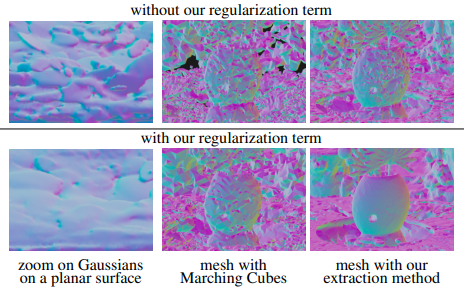
- surface 근처의 점 sampling :
- assumption :
거의 surface 위에 있다고 볼 수 있을 정도로 아주 가까운
surface 근처의 \(p\) 를Gaussian들의 곱 분포로 sampling
\(p \sim \prod_{g} N(\cdot; \mu_{g}, \Sigma{g})\)- ‘3DGS가 잘 학습됐다면’ small Gaussians는 surface에 아주 가까운 점들의 확률처럼 생각할 수 있고,
Gaussian이 작을수록 sampling이 중심에 집중되므로
그 small Gaussians의 곱이 나타내는 분포는 surface 근처의 좁은 영역에 집중된 분포를 나타낼 것이고,
이로부터 sampling한 점 \(p\) 는 실제 object surface에 가까울 확률이 높다는 가정 - 이렇게 sampling한 points는 regularization term에 대해 high gradient를 가지는 부분임
- ‘3DGS가 잘 학습됐다면’ small Gaussians는 surface에 아주 가까운 점들의 확률처럼 생각할 수 있고,
- assumption :
-
density function:- \(d(p) = \sum_{g} \alpha_{g} \text{exp}(-\frac{1}{2}(p - \mu_{g})^T \Sigma_{g}^{-1}(p - \mu_{g}))\)
where \(\text{exp}(-\frac{1}{2}(p - \mu_{g})^T \Sigma_{g}^{-1}(p - \mu_{g}))\) : posterior
(점 \(p\) 에 더 가까운 Gaussian의 \(\alpha_{g}\) 가 \(p\) 의 density에 더 많이 기여)
where \((p - \mu_{g})^T \Sigma_{g}^{-1}(p - \mu_{g})\) :Mahalanobis distance
(\(p\) 가 Gaussian distribution 평균 \(\mu_{g}\) 에서 “상대적으로” 얼마나 떨어져 있는지)
(\(p\) 가 평균으로부터 같은 거리만큼 떨어져있더라도 convariance가 작은 방향에 있을수록 Mahalanobis distance가 커짐) - approx. ideal density function \(\bar d(p) \in [0, 1]\) :
- 가정 1) well-distributed Gaussians by regularization term 이므로
overlap 없다는 전제 하에하나의 Gaussian \(g^{\ast}\) 가 point \(p\) 의 density 결정 - 가정 2) Gaussians가 진짜 surface를 묘사하려면
semi-transparent하지 않아야좋음
\(\rightarrow\) \(a_{g} = 1\) for any Gaussians - 위의 가정과 아래 수식 유도(Approximation of Density function) 에 따르면
\((p - \mu_{g})^T \Sigma_{g}^{-1}(p - \mu_{g}) \approx \frac{1}{s_{g}^2} \langle p-\mu_{g}, n_g \rangle^{2}\) 이고
근사해서 구한 ideal density function은
\(\bar d(p) = \text{exp}(-\frac{1}{2s_{g^{\ast}}^2} \langle p-\mu_{g^{\ast}}, n_{g^{\ast}} \rangle^{2})\)
where \(g^{\ast} = \text{argmin}_{g}(p - \mu_{g})^T \Sigma_{g}^{-1}(p - \mu_{g})\)
- 가정 1) well-distributed Gaussians by regularization term 이므로
- \(d(p) = \sum_{g} \alpha_{g} \text{exp}(-\frac{1}{2}(p - \mu_{g})^T \Sigma_{g}^{-1}(p - \mu_{g}))\)
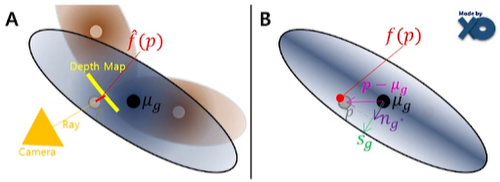
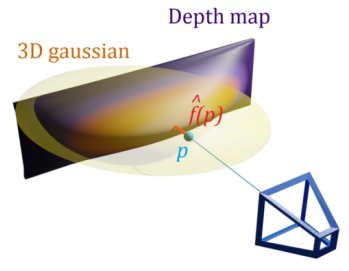
-
Regularization on density:- \[R = | d(p) - \bar d(p) |\]
- \(d\) :
densityfunction - \(\bar d\) : approx.
ideal densityfunction
where 하나의 불투명한 Gaussian이 point density 결정
- \(d\) :
- 근데 density function \(d\) 로 regularize하면 아래의 문제가 있다
- \(d\) 는 exponential term으로 이루어져 있으므로 scale이 너무 커서 optimization에 별로다
- approx. ideal density function을 구할 때 flat Gaussian으로 surface를 나타내는 게 목적이라고 가정하였는데,
Gaussian이 완전히 flat 하면 \(s_{g} = 0\) 이 되어 \(\bar d(p) \rightarrow 0\) 이므로
모든 level set (표면)이 \(\mu_{g}\) 를 지나고 normal \(n_{g}\) 를 가지는 2D 상의 plane이 되어
level sets 고려하는 게 무의미해진다
따라서 surface를 나타내기 위해 flat하게 Gaussian을 만드는 게 목적이지만
그렇다고 완전히 flat하면 안 됨
- \[R = | d(p) - \bar d(p) |\]
-
Regularization on SDF:- density function 말고
SDF로 loss 만들면 optimization 더 잘 됨
(Gaussians가 surface에 더 잘 align됨)
\(R = \frac{1}{| P |} \sum_{p \in P} | \hat f(p) - f(p) |\)- \(f(p) = \langle p-\mu_{g^{\ast}}, n_{g^{\ast}} \rangle = \pm s_{g^{\ast}} \sqrt{-2log(\bar d(p))}\) :
ideal distance(SDF) b.w. point \(p\) and true surface
(\(\bar d(p) = 1\) 이면, 즉 SDF \(f(p) = 0\) (zero level-set)이면, true surface를 나타냄) - \(\hat f(p)\) :
estimated distanceb.w. point \(p\) and depth at projection of \(p\)
(\(f(p)\) 를 직접 계산하는 건 빡세므로 training view-points에 대해 Radix Sort로 Gaussian rasterize할 때 사용한 Gaussian depth 값들을 rendering하여 depth map을 만들어서 estimated \(\hat f(p)\) 구함)
- \(f(p) = \langle p-\mu_{g^{\ast}}, n_{g^{\ast}} \rangle = \pm s_{g^{\ast}} \sqrt{-2log(\bar d(p))}\) :
- density function 말고
-
Regularization on normalvector :- normal vector의 방향 \(n_{g}\) 을 SDF gradient 방향으로 맞춰주기 위해
(normal vector 방향을 잘 잡아줘야 surface에 잘 align됨)
\(R_{Norm} = \frac{1}{| P |} \sum_{p \in P} \| \frac{\nabla f(p)}{\| \nabla f(p) \|} - n_{g^{\ast}} \|^2\)
- normal vector의 방향 \(n_{g}\) 을 SDF gradient 방향으로 맞춰주기 위해
Approximation of Density function
-
density function이 실제 surface를 잘 나타낸다면
\(p\) 에 가장 기여가 큰 Gaussian이 surface에 align되어 flat해야 한다
이 때,flat Gaussian의 경우 Mahalanobis distance의 주 요인은covariance의 가장 짧은 축\(s_{g}\) 이므로
아래와 같이 approx. ideal density function 식을 유도할 수 있다 -
\(\bar d(p) = \text{exp}(-\frac{1}{2s_{g^{\ast}}^2} \langle p-\mu_{g^{\ast}}, n_{g^{\ast}} \rangle^{2})\) 유도 TBD
????
Eigendecomposition을 하면 \(\Sigma_{g} = Q \Lambda Q^T\)
where \(s_g\) : convariance가 가장 작은 방향의 vector
where \(n_g = \frac{s_g}{\| s_g \|}\)
Mesh reconstruction
Obtain Mesh
-
문제 :
Densification을 거치면 3DGS 수가 너무많아지고 너무작아져서
texture나 detail을 나타내기 힘듦
\(\rightarrow\) 거의 모든 곳에서 density function \(d = 0\) 이고,
위에서 언급했듯이 level sets 고려하는 게 의미가 없어져서
Marching Cubes 기법으로 이러한sparse density function의level sets를 추출하기 어렵 -
해결 :
- 과정 1)
Gaussians로 계산한 density function level set 상의visiblepart에 대해 3Dpoint sampling
\(n\) 개의 3D points \(\{ p + t_i v_i \}_{i=1}^n\) sampling
where \(p\) : depth map에 따른 3D point
where \(t_i \in [-3 \sigma_{g}(v), 3\sigma_{g}(v)]\) (visible part)
where \(v_i\) : ray direction - 과정 2)
\(d_i = d(p + t_i v_i) = \sum_{g} \alpha_{g} \text{exp}(-\frac{1}{2}((p + t_i v_i) - \mu_{g})^T \Sigma_{g}^{-1}((p + t_i v_i) - \mu_{g}))\) 로
density 계산한 뒤 level parameter \(\lambda\) 에 대해
\(d_i \lt \lambda \lt d_j\) 이면,
range \([d_i, d_j]\) 안에level set point있다고 판단
(아! 그 범위 안에 표면 위의 점이 있구나!) - 과정 3)
해당 level set points와 normals (oriented 3d point clouds \(\vec V\))를 이용하여
Poisson reconstruction으로 surfacemesh얻음
(아래에서 설명)
- 과정 1)
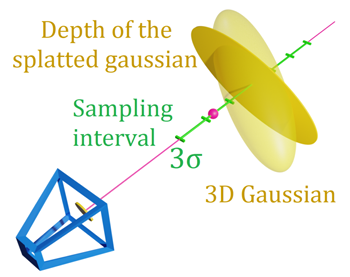
Mesh by Poisson Reconstruction
-
Poisson surface reconstruction :
3D Point Clouds를3D Mesh로 변환하는 고전적인 방법 (출처 : Link) -
Let indicator function \(\chi_{M}(p) = \begin{cases} 1 & \text{if} & p \in M \\ 0 & \text{if} & p \notin M \end{cases}\)
where \(M\) : object mesh 내부
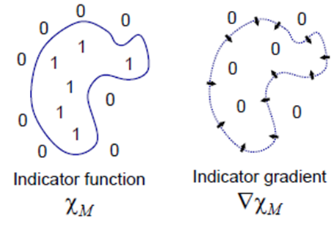
- 주어진
oriented 3d point clouds\(\vec V\) 를 approx.하는indicator gradient\(\nabla \chi\) 를 찾아야 한다
이를 풀기 위해 Possion Equation을 사용하자-
Possion Equation:
\(\nabla^{2} \phi = f\)
where \(\nabla = (\frac{\partial}{\partial x}, \frac{\partial}{\partial y}, \frac{\partial}{\partial z})\)
\(\rightarrow\)
\((\frac{\partial^{2}}{\partial x^2}+\frac{\partial^{2}}{\partial y^2}+\frac{\partial^{2}}{\partial z^2}) \phi (x, y, z) = f(x, y, z)\)
여기서 scalar field \(f\) 가 주어지면,
scalar field \(\phi\) 를 찾을 수 있다 - \(\nabla \chi \approx \vec V\) 원하는 상황인데
양변에 divergence를 취하면
\(\nabla \cdot \nabla \chi = \nabla \cdot \vec V\) 은 Poisson Equation 꼴이므로
\(\nabla \cdot \vec V\) 를 알면 \(\chi\) 를 알 수 있다
-
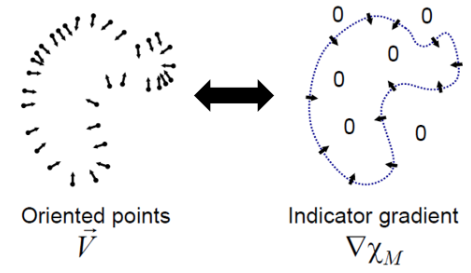
- Implementation :
- oriented 3d point clouds가 주어지면
모든 points를 포함하는 큰 육면체를 만들고
이를Octree(육면체를 8등분하는 tree)를 사용하여 분할 (Fig 1.) - input point clouds \(\vec V\) 는 주변 octree들의 합으로 설계하고,
octree node의 depth는 Gaussian의 variance로 설계하여
input point clouds 근처의 octreee들을 Gaussian으로 표현하면
vector field \(\vec V\) (Fig 2.) 를 얻을 수 있다 - 각 차원을 편미분 (Divergence)하면 scalar field \(\nabla \cdot \vec V\) (Fig 3.)를 얻을 수 있고,
Poisson equation \(\nabla \cdot \nabla \chi = \nabla \cdot \vec V\) 에 의해
indicator function \(\chi\) 도 알 수 있다
octree의 깊이 별로 각 node의 \(\nabla \vec V\) 값 (Fig 3.)과 \(\nabla \nabla \chi\) 값 (Fig 4.)의 차이를 최소화함으로써 indicator function \(\chi\) 를 구한다 - mesh화 : input point clouds를 indicator function \(\chi\) 의 입력으로 넣어서 나온 결과값들을 평균 내고, 이 값과 같은 값을 출력하는 좌표들을 surface로 간주 (Fig 5.)하여 Marching Cube 알고리즘으로 mesh 생성
(Octree Node마다 Marching Cube Polygon 생성)
(여러 fine Octree Node가 하나의 coarse Octree Node를 공유할 때 생기는 문제를 해결하기 위해 fine Octree Node 면의 부분을 coarse한 면으로 projection하는 방법 사용) - octree 깊이가 깊어질수록 시간과 memory를 많이 잡아먹긴 하지만, recon.하는 mesh 수가 더 많아서 mesh fine detail을 살릴 수 있음 (Fig 6.)
- oriented 3d point clouds가 주어지면
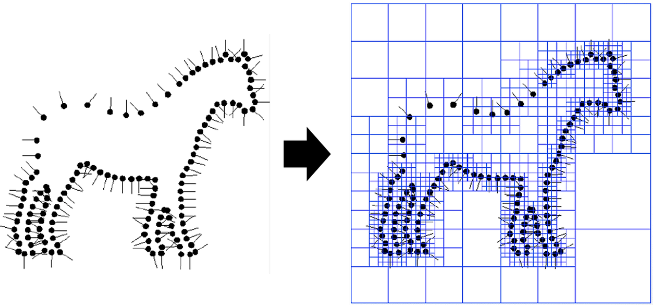
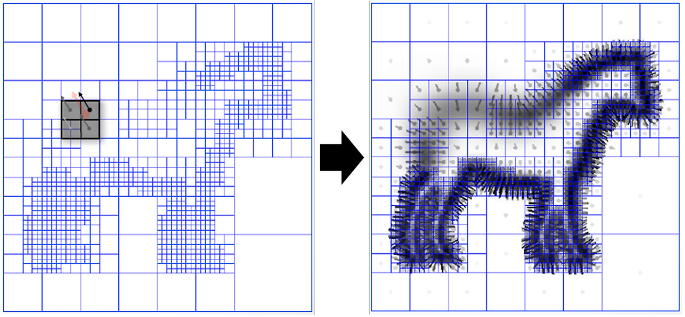
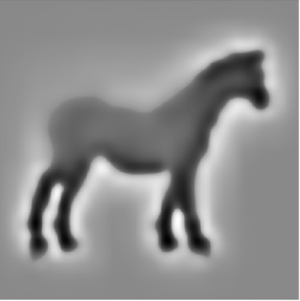

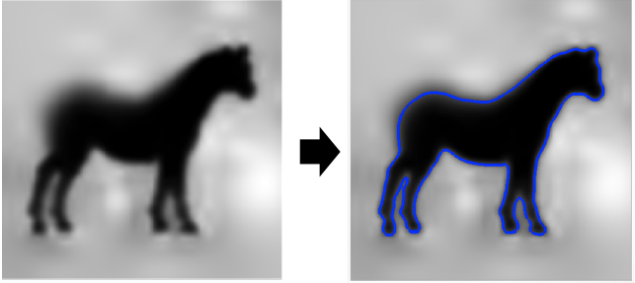
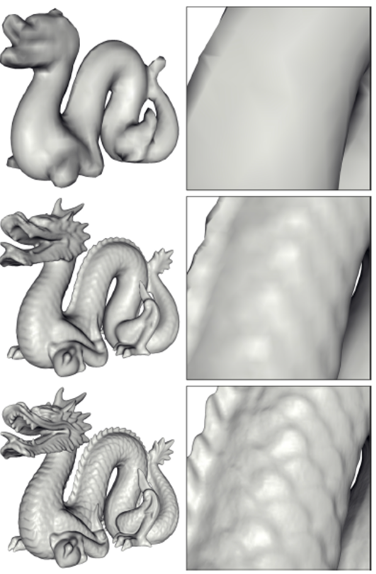
Refine Mesh
Refine Mesh by Gaussians
-
문제 :
Poisson reconstruction으로 구한 mesh만 사용하면 rendering quality가 좋지 않음 -
해결 :
새로 sampling한 new Gaussians를 (triangle) mesh에 binding하고,
해당Gaussians과mesh를 GS rasterizer로함께 optimize- 과정 1)
mesh surface 상에서triangle당 \(n\) 개의new thin 3D Gaussians를 sampling하여
Gaussians를 triangle에 bind - 과정 2)
mesh vertices in barycentric coordinate (무게중심 좌표계) 이용해서
각 Gaussian의 mean을 explicitly 계산할 수 있음
(barycentric coordinate : 삼각형 내부의 점을 세 꼭짓점의 가중치로 표현) - 과정 3)
Gaussians를 mesh triangle에 aligned되도록 flat하게 유지하기 위해
each Gaussian은 2개의 learnable scaling factor \(s_x, s_y\) 와 1개의 learnable 2D quaternion \(q=a+bi\) 을 가지고 있음
(Gaussians optimize하여 mesh optimze될 때 new thin Gaussians도 함께 optimize)
- 과정 1)
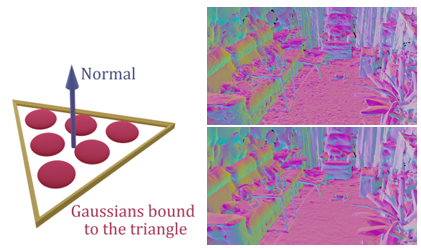
Code Flow
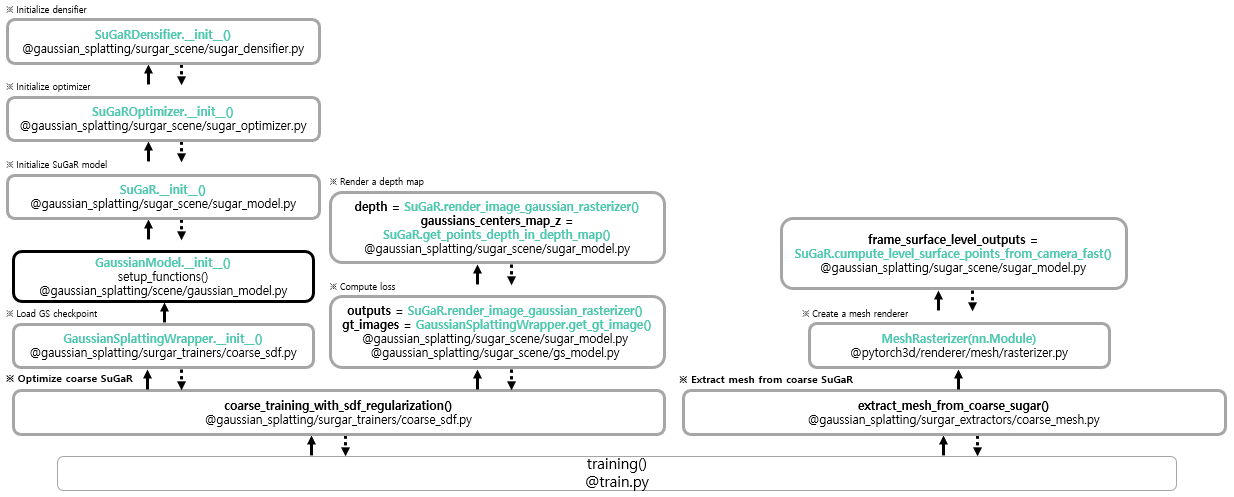
Question
- Q1 : well-distributed 가정을 따르는 approx. ideal density function을 직접 구해서 이를 density function과 비교하는데, GT 역할을 하는 approx. ideal density function이, 변하는 learnable Gaussian으로 구한 것이어도 학습이 안정적임?
- A1 : TBD